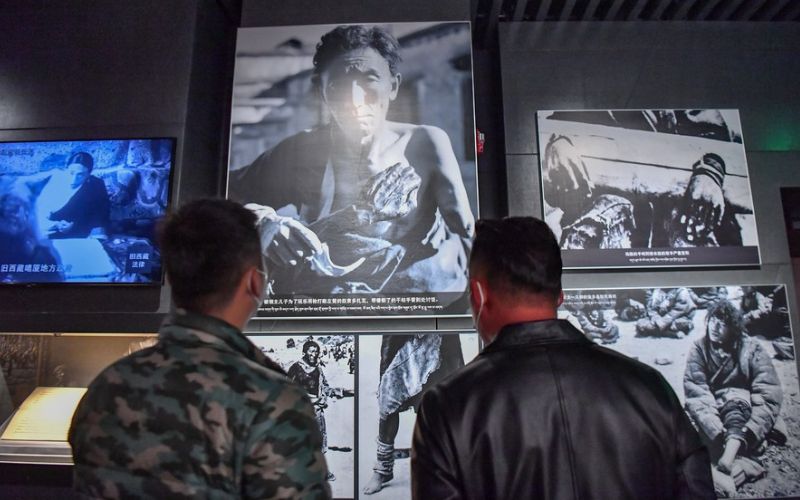
Xinhua
Museums play a key role in the preservation and promotion of cultural heritage and help understand history better. However, the presence of museums & cultural institutions in occupied Tibet is striving to legitimize China's claim to authority over the region, as well as to promote a particular Chinese narrative about Tibetan history & culture.
The so-called Tibet Museum in Lhasa city claims to be a “36 meters high building with 1100 windows and exhibitions on Tibetan folk culture, customs of living, eating habits of Tibetans, costumes, textiles, and residential areas”. The original Tibet Museum (with artifacts mostly taken from Potala Palace) was officially opened on 5th October 1999, to mark the 50th anniversary of ‘The PRC’s Economic Reform in Tibet’. The museum’s exhibition narratives tried to highlight that the modernization of Tibet has accelerated after the 17-point Treaty was signed in 1951 between Tibet and China, and to reinforce the historical legitimacy of handing Tibet over to China. It displayed collections of artifacts, including official documents and gifts exchanged between Chinese Han Dynasty officials and Tibetan leaders.
In 2021, CCP launched a “memorial hall” to “display the photos and items from the serfdom era”. The hall claimed to showcase “torture instruments and ritual artifacts made from serfs' bones and skin, and those recording the democratic reform and serfs' new lives”. This is in continuation of the CCP propaganda of the so-called ‘Serf Emancipation Day’ - it was invented in January 2009, more specifically to counter the March 10th Tibetan uprising day. As pointed out by Tsewang Gyalpo Arya, all these talks of liberation, democratic reform, and economic development are a farce and pure propaganda to mislead the international community and to justify its illegal occupation of Tibet.
The Potala Palace, the erstwhile winter palace of His Holiness the 14th Dalai Lama has also been converted to a museum. With nearly 800 sensors placed around the palace, multiple monitoring tools, and nine kilometers of fiber optic cables installed inside, the sacred space of Tibetans has been reduced to a spectacle. Today, Potala Palace has been commodified as a tourist attraction; China state-sponsored media and Chinese bureaucrats use Potala as the poster child for Han Chinese tourism. This, along with the musealisation of the palace, are an attempt to erase the past, and the religious and cultural significance of the Tibetan structure.
Tibet Revolution exhibition hall located in the east in front of Potala Palace in Lhasa was completed in 1965 and it holds exhibitions, with a focus on “achievements of the construction of a new socialist Tibet and serf indignation”.
Archaeology is being used as a tool by China to misinterpret history and change narratives. According to Aadil Brar, the Chinese government's discovery of new archaeological sites from pre-historic periods has been used as a political tool to suggest that Tibet was always integrated with the Chinese mainland, thus denying Tibet's unique history. Such claims stand in stark contrast to the Chinese government's current efforts to destroy Tibetan cultural and religious sites too. Despite claims of preservation of the past, the Chinese authorities have been engaged in a "Cultural Revolution"-like a crackdown on Tibetan culture, systematically destroying cultural and religious sites that are vital to the region's identity.
The construction of museums in Tibet has also been linked to the CCP's broader efforts to boost tourism in the region, which is a form of cultural colonization.
There is one museum that serves as a testimonial to the resistance and resilience of Tibetans forced into exile by China. The Tibetans-in-exile have been putting up a brave fight against the misrepresentation of their past by China. The Tibet Museum at Dharamshala, India is a “museum made by and for Tibetans” with an aim to “challenge the representations of Tibet and Tibetan people that feature in museums in China” and elsewhere. The museum tells a “different story”; Tibet in this museum “has a past, a present and a future”, unlike China’s museums which are packaged spectacles that tell stories of pain, anger and betrayal.